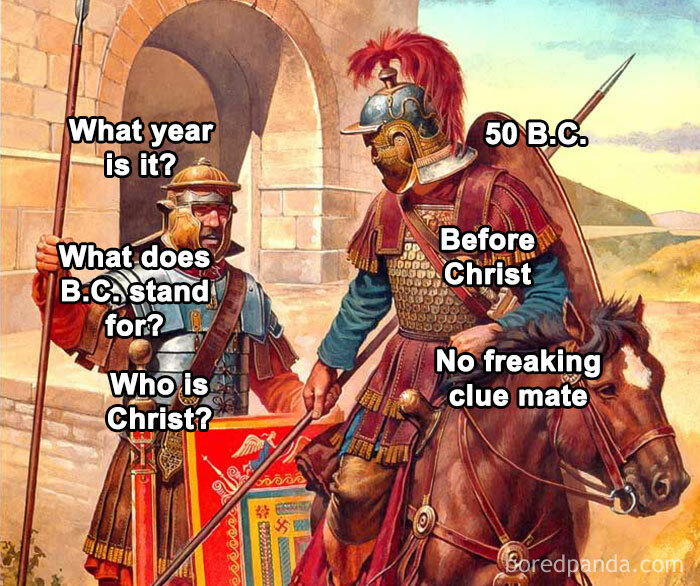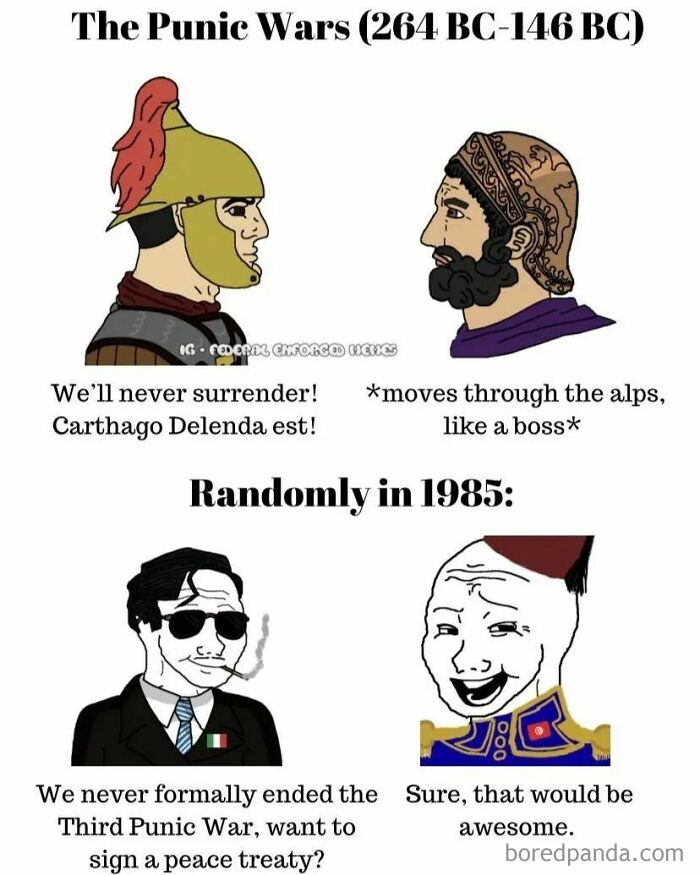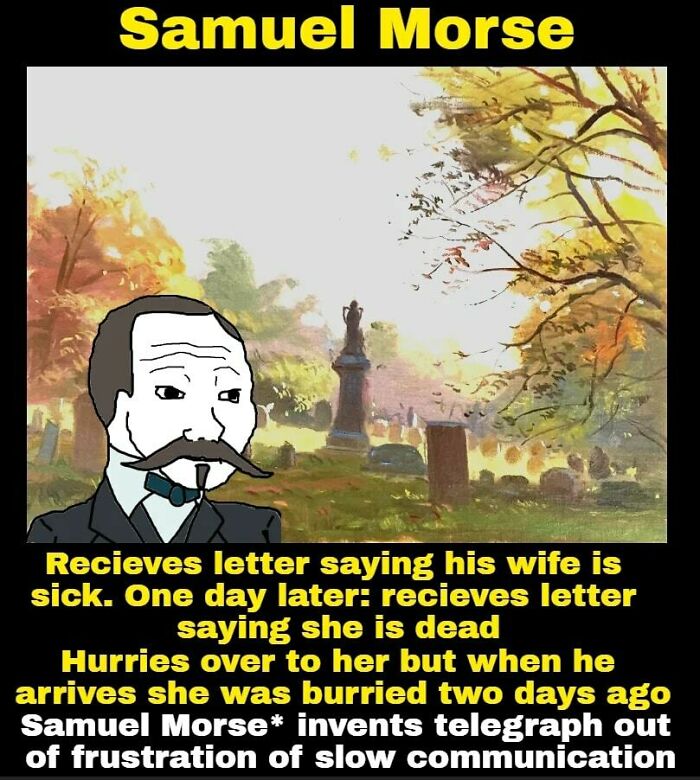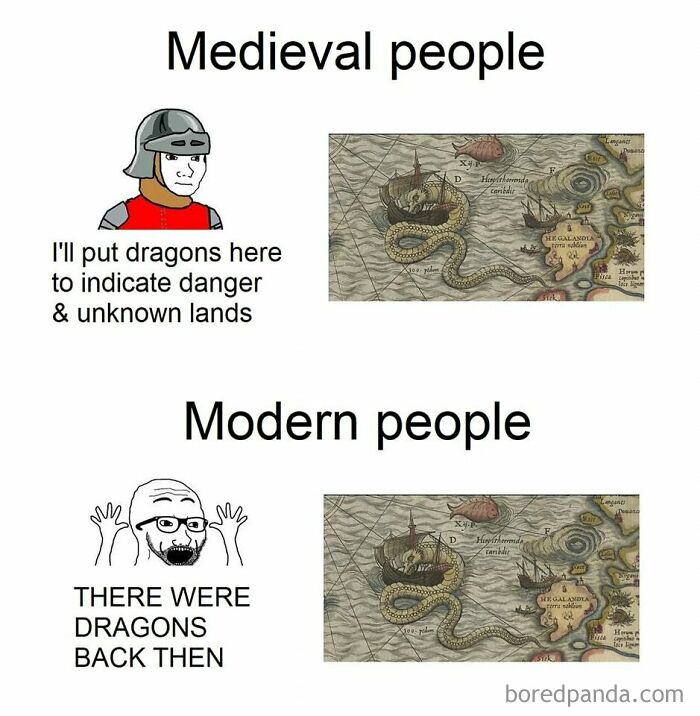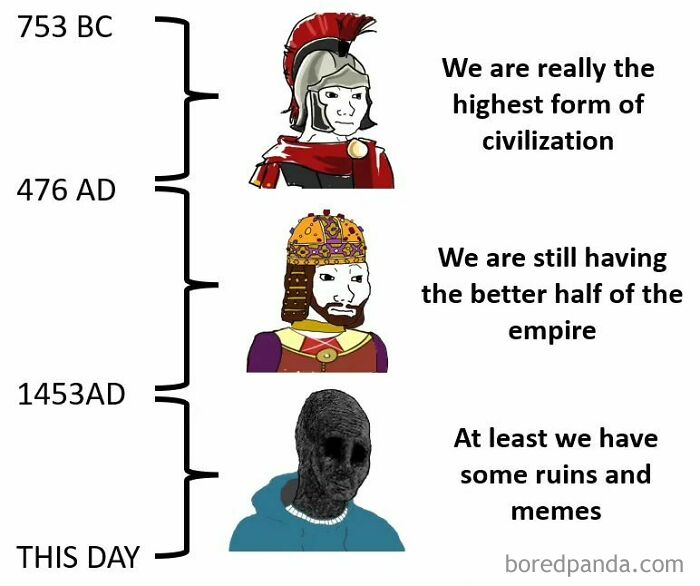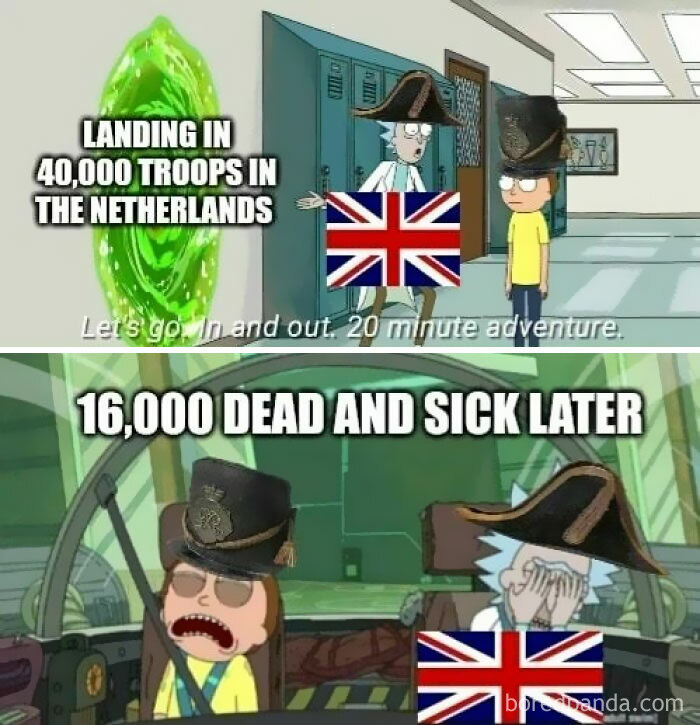When people talk about social media, it is usually presented in a bad light. It makes us feel more insecure, it messes up our attention spans, and it makes us drop our goals for that sweet instant gratification. To put it simply, it is bad in many different proven ways.
However, there are some good things about it, too. One of them is the fact that it provides easy access to information. If we curate our social media feeds responsibly, we can learn from scrolling on our phones.
One such account that is dedicated to spreading knowledge on the internet is Daily Historian on Instagram. There, you will find not only funny memes and pictures but also interesting stories from our history. Scroll down to read our favorite ones.
This post may include affiliate links.
The B.C. and A.D. system is a dating system used to label or number years in the Gregorian and Julian calendars. B.C. stands for "Before Christ," referring to the time before the birth of Jesus Christ, while A.D. stands for "Anno Domini," a Latin phrase meaning "in the year of our Lord," referring to the time after the birth of Jesus Christ. However, it is important to note that scholars later determined that Jesus was born around 6–4 B.C., not A.D. 1. The B.C. and A.D. dating system was not taught in the Bible and was not fully implemented and accepted until several centuries after Jesus' death. B.C.E. and C.E. are alternative dating systems that have gained popularity in recent times. B.C.E. stands for "Before Common Era," and C.E. stands for "Common Era." These terms are equivalent to B.C. and A.D., respectively, but they remove the explicit reference to Christ, making them more inclusive and sensitive to non-Christian beliefs. The use of B.C.E. and C.E. dating system first appeared in the 17th century in German and in the 18th century in English. Today, the use of B.C.E. and C.E. has become fairly common among other groups for similar reasons.
It's worth noting that not every country uses CE/BCE. In Nepal for example it's the year 2080. In Thailand it's 2566 Buddhist Era.
Informational social media accounts might be perceived as simply entertaining and not really having a lasting value, but they do offer us an opportunity at microlearning.
Microlearning is an educational approach that encourages people to learn things in small, focused portions. This type of approach not only increases information retention, but also helps students build confidence in their knowledge.
In 1254, Möngke Khan, the grandson of Genghis Khan, hosted a religious debate between Christian, Muslim, and Buddhist theologians. Möngke Khan was known for his religious pluralism and had a keen interest in learning about different religions. The debate was organized similarly to wrestling matches, with a panel of judges overseeing it, including a Christian, a Muslim, and a Buddhist. A large audience gathered to watch the event, which began with great seriousness and formality. The debate covered various topics such as evil versus good, God's nature, the fate of animal souls, the existence of reincarnation, and whether God created evil. The clerics formed shifting coalitions among the different religions according to the topic being discussed. Between each round of the debate, the participants were required to drink alcohol as well. This led to the debaters becoming increasingly intoxicated, and ending with the Buddhists sitting silently while the Christian and Muslim debaters sang loudly at each other.
Historical empathy refers to the ability to understand and appreciate the thoughts, feelings, and experiences of people from different historical periods and cultures. It involves setting aside our own personal opinions and judgments to better comprehend the motivations, beliefs, and actions of individuals or groups in the past. As someone who studied history as an undergrad, this skill is essential for students of the field. It allows them to engage in historical inquiry and develop a deeper understanding of historical contexts. Historical empathy is not about feeling sorry for historical figures or sympathizing with their points of view. Instead, it is an attempt to understand their perspectives and the reasons behind their actions. This process involves two main components: historical contextualization and perspective-taking. Historical contextualization involves situating events and people within their broader historical context, while perspective-taking requires understanding the mentality, beliefs, values, and intentions of historical agents. In the classroom, historical empathy can be used to help students engage with history and process their own roles in the world today. By understanding people in the past and contextualizing their actions, students can better comprehend how the past has shaped the present and consider the impact of their choices on their own lives and communities.
Microlearning is characterized by a few qualities. The most important one of them is, of course, the amount of the information presented. It is quite brief, only delving into one specific area and allowing the learners to walk away fully understanding it.
Al Capone, the infamous American gangster, is often credited with popularizing expiration dates on milk bottles in the 1930s. The story goes that one of Capone's family members got sick after drinking expired milk, which led Capone to take an interest in the milk industry. He bought a milk processor called Meadowmoor Dairies and lobbied the Chicago City Council to pass a law requiring visible date stamps on milk containers. However, there are alternative theories about Capone's involvement in the milk industry. Some reports suggest that he was looking for a legitimate business to fund his lifestyle after the end of Prohibition. It is believed that all stamping equipment for milk expiration dates was under his control, and after Chicago passed the law mandating visible expiration dates on milk bottles, Capone had the ability to effectively control the local milk market.
The story goes that in his later years Capone realized he could have made more money selling milk than booze. Crime DOES pay but mostly it doesn't pay as well as legitimate business.
During the D-Day landings in June 1944, the captain of the USS Texas intentionally flooded the ship's hull to achieve a specific goal. The Allied forces had advanced inland, and the battleship's guns couldn't aim high enough to reach their intended targets due to insufficient elevation. To overcome this limitation, the crew flooded the starboard torpedo blister, a sponson on the hull below the waterline, causing the ship to list two degrees to starboard. This additional angle allowed the battleship's guns to fire accurately and complete the mission, providing crucial support to the invasion forces. This daring move was unconventional, but it demonstrated the spirit of the Allied forces during the Normandy operation and contributed to the overall success of the invasion.
While the story of the Texas at Normandy is an interesting one, it is worth noting that the practice of heeling the ship to extend the range of the guns goes back at least to the Napoleonic wars.
Henry Avery was an English pirate who operated in the Atlantic and Indian Oceans in the mid-1690s. He was born around 1653 in Cattedown, Plymouth, England. Avery began his career at sea, following in his father's footsteps, and eventually joined the Royal Navy, serving as a midshipman on the HMS Kent and HMS Rupert. Avery's pirate career started when he was the first mate aboard the warship Charles II. The crew mutinied due to unpaid wages and Avery was elected captain of the newly renamed pirate ship, the Fancy. In 1695, Avery and his crew captured a treasure ship of the Mughal emperor, which carried cargo worth over $95 million today. This heist made Avery one of the most successful pirates in history and earned him the nickname "Long Ben". His exploits captured the public's imagination, inspired others to take up piracy, and spawned works of literature. Despite the large bounties offered for his capture, Avery managed to evade arrest and was never caught. His ultimate fate remains a mystery, with some legends suggesting that he lost his fortune to unscrupulous merchants and died in poverty in England. Others believe he made a clean getaway and retired with his loot. Regardless of his fate, Henry Avery remains one of the most notorious and successful pirates in history.
American modern day pirates: steals billions and hides them in overseas banks.
Another feature is that it often uses different forms of multimedia to convey the message. This can be a short-form video, a picture, a quiz, or a game. This enhances the learning experience, making it more fun and engaging. The entertainment aspect helps learners to better retain the information.
The Cobra Bounty in British India refers to an incident during the British colonial rule in India when the British government, concerned about the number of venomous cobras in Delhi, offered a bounty for every dead cobra. The intention was to reduce the cobra population and make the city safer. Initially, the strategy seemed successful, as large numbers of snakes were k***ed for the reward. However, enterprising individuals began breeding cobras to profit from the bounty system. When the British authorities realized this, they canceled the bounty program. As a result, the cobra breeders released their now-worthless snakes into the wild, causing the wild cobra population to increase even further. This incident is often cited as an example of the Cobra Effect, which refers to the unintended negative consequences of an incentive that was designed to improve society or individual well-being. The term was coined by economist Horst Siebert based on this anecdote.
The Puritans were a group of English Protestants in the 16th and 17th centuries who sought to purify the Church of England of Roman Catholic practices. They believed in a covenant relationship with God, and their teachings were heavily influenced by Calvinist theology. They saw themselves as the elect chosen by God to live godly lives both as individuals and as a community. Despite being persecuted for their religious beliefs in England, the Puritans, once in control in New England, did not extend the religious freedom they sought to others. They supported the Old World theory that sanctioned religious uniformity in the state. They expelled dissenters from their colonies, including notable figures like Roger Williams and Anne Hutchinson. Those who defied the Puritans by persistently returning to their jurisdictions risked capital punishment. The Puritans' intolerance was rooted in their belief that they were practicing the only true religion, and therefore everyone should be forced to worship as they did. Ministers like the Reverend John Cotton preached that it was wrong to practice any religion other than Puritanism. Those who did would be helping the devil. However, the Puritans' ability to enforce a single religion in their colonies was short-lived. Not only did Quakers, Baptists, and other non-Puritans move in, but when Charles II came to the throne in 1660, he turned a dark eye on Congregationalism, spelling the eventual end of its religious domination in New England.
Marcus Licinius Crassus, a wealthy Roman businessman and a member of the first Triumvirate along with Pompey and Julius Caesar, died in 53 BC during the Battle of Carrhae. His death is shrouded in mystery and legend, with various accounts of his demise. One account suggests that Crassus was k***ed in a scuffle, possibly by a man named Pomaxathres. Another account states that Crassus was k***ed after refusing to surrender to the Parthians. According to this version, Crassus was wounded in the battle and attempted to negotiate with the Parthians. However, the Parthian general, Surena, ordered that Crassus be k***ed, and his head was cut off and brought to the Parthian king. Yet another account suggests that Crassus was enticed to parlay with Surenas and was k***ed during this meeting. His head and hand were then sent to Orodes II, the Parthian king. There is also a rich set of myths surrounding Crassus's death. One such myth suggests that the Parthians poured molten gold into his mouth, symbolizing the futility of his greed. This account is also supported by other sources, which state that Crassus was k***ed shortly after the Battle of Carrhae by the Parthians who, according to Roman tradition, poured liquid gold into his throat. Regardless of the exact circumstances of his death, Crassus's demise had significant political implications.
A big part of microlearning is how flexible it is. You do not need to follow a specific timeline for learning. You learn at your own pace as long as you have a device that allows you to access the information.
Pope John Paul II is said to have given his blessing to the Pokémon franchise in 2000. The main reasons for this were that he believed the games did not have "any harmful moral side effects" and were based on "ties of intense friendship." The Vatican-based satellite TV station, Sat2000, which was run by the Italian Bishops' Conference, also described the game as "full of inventive imagination." The station further noted that Pokémon encourages its young players to think creatively to overcome challenges without resorting to violence. It was also mentioned that the game tells simple stories that allow children to immerse themselves directly into the story through role-playing adventures.
It's a franchise about capturing wild animals and forcing them to fight for our entertainment. If you replace Pokemon with different breeds of dog you suddenly have a very illegal and cruel activity.
Land reclamation plays a significant role in the history of the Netherlands, which has a long and ongoing struggle against the sea. The primary reason for land reclamation in the Netherlands is the country's unique geography. A large part of the Netherlands is below sea level, making it vulnerable to floods and storms. The earliest recorded land reclamation in the Netherlands dates back to the 11th century when farmers in the coastal regions began to build dikes to protect their farmland from the constant threat of flooding. In the 17th century, the Dutch took land reclamation to a whole new level with the creation of polders. A polder is a low-lying area that has been surrounded by dikes and drained of water, creating new land that can be used for agriculture or development. By the end of the 17th century, over 200,000 hectares of land had been reclaimed in this way. One of the most significant projects was the draining of the Haarlemmermeer, a large lake near Amsterdam, which took 30 years to complete.
Dogs were highly valued in ancient Rome, as they were in other cultures, and the Roman dog served many of the same purposes as it did in other cultures, such as hunting, guarding, and companionship. The Romans created their own artistic dog collars, some of which were made of gold, and they were considered the best protection against ghosts or evil spirits. The Romans viewed dogs far more pragmatically than other cultures, and their treatment of dogs was more grounded. They cared for them as they would family members and honored them when they died with tombs and epitaphs. The swift Laconian (Spartan) and the powerful Molossian were the best-known canine breeds mentioned by classical authors, both of which were native to Greece and used by the Romans for hunting and to watch over the house and livestock. Hounds from Celtic Britain were also famous and exported to Rome even before the conquest. Dogs, and their wolf-ancestors, had a long history with the Romans, as evidenced by the famous tale of the mythical founders of the city, Romulus and Remus, who were said to have been suckled by a she-wolf as infants before they were found and raised by a shepherd.
A good example of microlearning can be a science-oriented TikTok or YouTube page, like one that Hank Green has. Apps like Duolingo are also considered microlearning tools as they gamify language learning. You could also consider checking out a 'word' or 'fact of the day' as a type of microlearning. Which is why informational social media accounts are up there, too.
Leonardo da Vinci dissected corpses to gain a deeper understanding of the human body for both his art and scientific pursuits. He believed that understanding the human body's structure and function would help him create more realistic and accurate art. Da Vinci was also fascinated by the human body as a creation of nature and sought to comprehend its physical workings. Though he lacked formal medical training, da Vinci is believed to have dissected more than 30 bodies in his lifetime. Initially, he dissected animals and later compared their anatomy to that of humans. In the 1500s, as his reputation grew, he was allowed to dissect corpses in medical universities and hospitals. Before this, he had to rely on grave robbers to acquire corpses, as human corpse dissection was legalized only for medical universities and doctors who performed post-mortems. Da Vinci's anatomical drawings were incredibly accurate and detailed, reflecting his meticulous dissections and his skills as a draftsman. His studies of the human body were groundbreaking at the time and contributed significantly to the understanding of human anatomy.
Operation PX was proposed in December 1944 by the Japanese Naval General Staff, led by Vice-Admiral Jisaburō Ozawa. The name for the operation came from the Japanese use of the code name PX for Pestis bacillus-infected fleas. In planning the operation, the navy partnered with Lieutenant-General Shirō Ishii of Unit 731, who had extensive experience on weaponizing pathogenic bacteria and human vulnerability to biological and chemical warfare. The plan for the attack involved Seiran aircraft launched by submarine aircraft carriers upon the West Coast of the United States—specifically, the cities of San Diego, Los Angeles, and San Francisco. The planes would spread weaponized bubonic plague, cholera, typhus, dengue fever, and other pathogens in a biological terror attack upon the population. The submarine crews would infect themselves and run ashore in a s*****e mission. Planning for Operation PX was finalized on March 26, 1945, but shelved shortly thereafter due to the strong opposition of Chief of General Staff Yoshijirō Umezu. Umezu later explained his decision as such: "If bacteriological warfare is conducted, it will grow from the dimension of war between Japan and America to an endless battle of humanity against bacteria. Japan will earn the derision of the world."
Biowarfare is terrifying. We all lived through 2020. COVID was just a natural epidemic. A man made epidemic is even more terrifying.
All of that to say that we are learning all the time, taking in information from our surroundings. Choosing to subscribe to informational content is a step towards more knowledge. Just remember to carefully curate what you read and only listen to reliable information.
The Argentine Poodle Incident refers to a tragic event that occurred on October 21, 1988, in Buenos Aires, Argentina. A poodle named Cachi fell from a 13th-floor balcony and landed on a 75-year-old woman named Marta Espina, k***ing both the woman and the dog instantly. The incident led to two more deaths. A second woman was k***ed after a bus hit her as she came to see what had happened. An unidentified man who witnessed the second woman's death had a heart attack and died on the way to the hospital. The incident began when Cachi was playing with a tennis ball in the Montoya family's apartment. The ball bounced too far, and Cachi chased it onto the balcony, eventually falling through the railings to the street below.
The Aztecs followed the Spanish around with incense burners when they arrived in Mexico. The Spaniards believed this to be a divine honor, but it was actually a necessity due to the wide gap in hygiene between the two peoples. The Aztecs used a variety of deodorants, including flowers and oils, whereas incense was used in different ritual contexts. The Spaniards' smell was so unbearable to the Aztecs that they used their ritual incense to mask it. The Aztecs were known for their cleanliness and personal hygiene, and they bathed often, and many of them every day in the rivers, lakes, or pools. The Spaniards' hygiene was poor, and they were unable to stay clean in the conditions they were in.
The Aztec city of Tenochtitlan was far cleaner than any European city at that time. The accounts by the initial Spanish explorers describe a clean, technologically-advanced city with clean, paved streets; Europeans were still throwing the contents of their chamber pots onto mud streets.
Medieval monks played a significant role in the development of cheese and wine production techniques. They created various types of cheese and wine, which were essential for their diet and religious practices. Monks from different orders, such as Benedictines, Cistercians, Trappists, Franciscans, and Dominicans, created many legendary cheeses in Europe. Monastic and Benedictine houses were particularly involved in commercial cheese production, selling surplus stock. In England, for example, the Abbey of St. Albans had a rich monastic tradition in cheesemaking. Monks also developed "Monastery Cheeses" by washing the rinds of their cheeses with fermented, brewed drinks like abbey ales. Wine was essential for religious rites and was also a staple of the monks' diets. Monasteries and abbeys ventured into winemaking to ensure a steady supply of wine. Monks from the Benedictine and Cistercian orders, in particular, played a prominent role in the development of winemaking. They experimented with different grape varieties, winemaking techniques, and landscape management to improve the quality of their wines. In Burgundy, monks were responsible for maintaining winemaking knowledge and skills during the turbulent Middle Ages. In Champagne, the Benedictine monk Dom Pierre Pérignon introduced several viticulture and winemaking techniques in the 17th century.
The British and French were the first to develop tanks in World War I, with the goal of creating armored vehicles capable of crossing trenches, breaking through barbed wire, and providing protection for infantry. The first tank used in battle was the British Mark I, which made its debut during the Battle of the Somme in September 1916. The Mark I was a large, slow-moving vehicle with a rhomboidal shape, designed to cross trenches and crush barbed wire. It was armed with machine guns and/or cannons, depending on the variant. Although the Mark I had a dramatic effect on German morale and proved effective in crossing trenches and wire entanglements, it failed to break through the German lines. The French also developed tanks during World War I, with the first model being the CA 1. Later in the war, the French car company Renault produced the Renault FT, which became a more successful design. The German army also began to develop their own tanks as the war progressed. Early tanks faced several challenges, including slow speed, mechanical malfunctions, and vulnerability to enemy fire. Despite these issues, tanks played a significant role in World War I and contributed to the development of modern armored warfare.
In 1985, a symbolic peace treaty was signed between Italy and Tunisia, representing the modern cities of Rome and Carthage, respectively. The treaty was signed by Ugo Vetere, the mayor of Rome, and Chedli Klibi, the mayor of modern Carthage, on February 5, 1985. This event took place 2,131 years after the end of the Third Punic War, which was fought between Rome and Carthage from 149 to 146 BC. The signing of the peace treaty was a symbolic gesture to reinforce the relationship between Italy and Tunisia and to promote friendship and cooperation between the two cities. The Punic Wars were a series of three wars fought between Rome and Carthage from 264 to 146 BC. The First Punic War (264–241 BC) was primarily fought over the control of Sicily, with Rome emerging victorious and Carthage ceding Sicily and the Lipari Islands to Rome. The Second Punic War (218–201 BC) saw the famous Carthaginian general Hannibal crossing the Alps and invading mainland Italy, but ultimately, Rome defeated Carthage again. The Third Punic War (149–146 BC) resulted in the complete destruction of Carthage, the enslavement of its population, and Roman hegemony over the western Mediterranean.
The death of Samuel Morse's wife, Lucretia, had a significant impact on his motivation to create the telegraph. In February 1825, Morse was in Washington, D.C., working as a painter when his wife suddenly died at the age of 25. His father sent him a letter with the sad news, but due to the slow communication methods of the time, Morse did not receive it for several days. By the time he returned home to New Haven, Connecticut, his wife had already been buried. This personal tragedy inspired Morse to explore faster ways of communication. He wanted messages, like the news about his wife, to reach people more quickly and efficiently. This led him to develop the telegraph, which revolutionized long-distance communication by transmitting electrical signals over a wire laid between stations. Morse, along with Joseph Henry and Alfred Vail, invented an electrical telegraph system in 1836. The invention of the telegraph and the development of Morse code allowed for the simple transmission of complex messages across telegraph lines, significantly improving communication speed and efficiency.
The common narrative is that the USA was forced to use nuclear weapons. A realistic non nuclear resolution was possible. Operation Downfall was planned. We'll never know how that scenario would have played out. There's no point in arguing about it now, the decision was made almost 80 years ago. I recommend the HBO miniseries "Hiroshima" for context.
The Tuskegee Syphilis Study was a research experiment conducted by the U.S. Public Health Service and the Tuskegee Institute in Alabama between 1932 and 1972. The study aimed to observe the natural history of untreated syphilis in 600 Black men, 399 of whom had syphilis and 201 who did not have the disease. Participants were not informed about their diagnosis or the true purpose of the study. They were told they were being treated for "bad blood," a local term used to describe various ailments, including syphilis, anemia, and fatigue. In exchange for participating in the study, the men received free medical exams, meals, and burial insurance. The study continued even after penicillin became the recommended treatment for syphilis in 1947. Researchers did not offer treatment to the participants and convinced local physicians not to treat them either. The study was finally terminated in 1972 after it was exposed in the media, leading to public outrage and significant changes in research practices and ethical standards.
The P-59 Airacomet was the first operational jet-powered fighter aircraft used by the United States Army Air Forces (USAAF) during World War II. The first pilot of the P-59 was none other than Bell Aircraft Corporation's test pilot, Robert Morris Stanley. On October 2, 1942, Stanley was to make the first flight of the P-59. However, there was a catch - the USAAF had requested that Stanley wear a gorilla suit during the flight. The reason behind this strange request was to maintain secrecy. At the time, the development of jet engines was top secret, and the USAAF wanted to keep the P-59 project under wraps. So, they requested that Stanley wear a gorilla suit during the flight to make it appear as if the aircraft was being flown by a "crazy" pilot. The idea was that if anyone saw the aircraft flying, they would think it was a stunt or joke, rather than a top-secret military aircraft. Stanley complied with the request and donned the gorilla suit before climbing into the cockpit of the P-59. The flight was a success, and the P-59 went on to become the first operational jet-powered fighter aircraft used by the USAAF. The gorilla suit incident has since become a footnote in aviation history, but it serves as a reminder of the extreme measures taken during World War II to protect military secrets.
Not the craziest thing the allies did for secrecy during that war. Look uo "The Man Who Never Was".
Some Medieval maps used dragons to indicate unknown or dangerous areas as a way to represent the uncharted territories and the potential dangers that explorers might encounter. This practice is thought to be rooted in the Christian tradition, where dragons were associated with evil and Satan. Examples of dragons on historical maps include: -The Fra Mauro Map (c. 1450 AD): This map shows the "Island of Dragons" (Italian: Isola de' dragoni), an imaginary island in the Atlantic Ocean. Near Herat in modern-day Afghanistan, the map mentions dragons with stones in their foreheads that cure infirmities. -The T-O Psalter map (c. 1250 AD): This map features dragons as symbols of sin in a lower frame below the world, balancing Jesus and angels on the top. However, the dragons do not appear on the map proper. -The Borgia map (c. 1450 AD): A world map engraved on a metal plate, featuring a drawing of a dragon on its peripheral near the area that depicts Asia.
J. Robert Oppenheimer, known as the "Father of the Atomic Bomb," played a crucial role in the development of the atomic bomb during World War II. After the bombings of Hiroshima and Nagasaki, Oppenheimer expressed his guilt and remorse over the devastating consequences of the bomb. In a meeting with President Harry Truman in October 1945, Oppenheimer famously claimed to have "blood on his hands." This comment infuriated Truman, who believed that the responsibility for the bombings was his alone as the president. Truman's anger towards Oppenheimer's remark led to a strained relationship between the two. In later years, Truman would retell and embellish the story of their meeting, claiming that he sarcastically offered Oppenheimer a handkerchief to wipe his hands. Truman referred to Oppenheimer as a "cry baby scientist" and would never trust him again. Despite Oppenheimer's efforts to prevent the development of more powerful nuclear weapons, such as the hydrogen bomb, his opposition to the project and his alleged Communist ties led to his dismissal from the U.S. Atomic Energy Commission during the McCarthy era. Truman's decision to dismiss Oppenheimer was influenced by his concerns about the prospect of Soviet nuclear development and his belief that the responsibility for the bombings was solely his own.
I really like this story. It asks the question "Who is guilty of the murder?" The man who made the gun or the man who pulled the trigger? If only gun manufacturers and gun sellers had an ounce of Oppenheimer's remorse.
Taxation in medieval Europe was administered in various ways, depending on the region and the type of tax. In general, taxes were levied on land, trade, and movable property, and were collected by different authorities, such as the king, feudal lords, and the Church. In medieval England, the main form of taxation was land taxes, such as the geld, which was first regularly collected in 1012. The geld was unique in Europe at the time, as it was a universal land tax on all the king's subjects, not just his immediate feudal tenants and peasants. It was assessed on the hide, and the usual rate was 2 shillings per hide. In the 13th century, as people became rich from trade rather than land, kings began to impose taxes on trade. For example, King Edward I taxed every sack of wool that was exported to other countries. Taxes were also imposed on movable property, with people having to pay a percentage of their property's value (usually about 10%) to the king. Feudal lords could ask their vassals for an aid, a tax paid by persons or communities to someone in authority. Aids were limited to specific occasions, such as the knighting of the lord's eldest son, the first marriage of his eldest daughter, the payment of his ransom, or his going on a crusade. In addition, the lord of the manor could demand a taille, a tax from the inhabitants of his domain, which developed into the royal taille or tallage, a direct tax levied by sovereigns. Tax collection was often delegated to local governments or private tax collectors. In medieval Paris, the taille was an institution that resolved the tax compliance problem by turning the social cost of tax evasion into a private one.
The Walcheren Campaign was an unsuccessful British expedition to the Netherlands in 1809, intended to open another front in the Austrian Empire's struggle with France during the War of the Fifth Coalition. The campaign had two main objectives: capturing Flushing and Antwerp in the Netherlands and enabling navigation of the Scheldt River. The commander of the expedition was Sir John Pitt, 2nd Earl of Chatham. The campaign involved a large British force of 39,000 soldiers, 15,000 horses, and 616 ships. Despite the size of the force, the campaign failed to achieve its objectives and was plagued by disease, with over 4,000 British troops dying during the expedition, and only 106 of them dying in combat. The survivors withdrew on December 9, 1809. The Walcheren Campaign was a disaster for several reasons: 1. Poor timing: The British force landed after the Austrians had already been defeated, which meant that the campaign's goal of assisting Austria was no longer relevant. 2. Slow progress: The British army advanced too slowly, allowing the French to reinforce Antwerp and preventing the British from capturing i. 3. Poor communication: There was poor communication between the British military and naval commanders, which hindered the coordination of their efforts. 4. Disease: The campaign was severely affected by the outbreak of "Walcheren fever," which struck down a quarter of the entire army within three weeks. This fever was likely a combination of malaria, typhus, typhoid, and dysentery.
England has never had any luck with invading the Netherlands. Google up "Operation Market Garden".
The War of the Triple Alliance, also known as the Paraguayan War, was a South American conflict that took place from 1864 to 1870. It was fought between Paraguay and the Triple Alliance, which consisted of Argentina, the Empire of Brazil, and Uruguay. The war was the deadliest and bloodiest inter-state conflict in Latin American history. The war began when Paraguayan dictator Francisco Solano López perceived a threat to the regional balance of power after Brazil helped the leader of Uruguay's Colorado Party oust his Blanco Party opponent. In response, López, who had built up a 50,000-man army (the strongest in Latin America at the time), went to war with Brazil. Argentina's president, Bartolomé Mitre, then organized an alliance with Brazil and Colorado-controlled Uruguay, forming the Triple Alliance, and together they declared war on Paraguay on May 1, 1865. Despite having a much smaller army compared to the combined forces of the Triple Alliance, Paraguay managed to hold off its enemies for two years. In 1868, Brazil eliminated the Paraguayan army, k***ing, maiming, or capturing more than 10% of Paraguay's population.
The Dreyfus Affair was a political scandal that took place in France during the late 19th and early 20th centuries, centering around the wrongful conviction of a Jewish French army officer named Alfred Dreyfus for espionage. The affair exposed the deep divisions within French society over issues of nationalism, anti-Semitism, and the role of the military. In 1894, French military intelligence intercepted a letter from a German spy, which was found to have been written on a typewriter used by an army officer. Despite a lack of evidence, Dreyfus was accused of being the spy and was court-martialed in secret. He was found guilty and sentenced to life imprisonment on Devil's Island, a French penal colony in South America. Over the next few years, evidence began to emerge that suggested that Dreyfus was innocent and that the real spy was another French officer, Ferdinand Walsin Esterhazy. Despite this, the military refused to reopen the case and Dreyfus remained in prison. The affair became a cause célèbre, with supporters of Dreyfus and his innocence (known as Dreyfusards) clashing with his detractors, who were often anti-Semitic and nationalist. In 1898, writer Emile Zola published an open letter titled "J'Accuse" in a prominent Paris newspaper, accusing the military of a cover-up and demanding a retrial for Dreyfus. This led to a national scandal and a retrial was eventually granted. In 1906, Dreyfus was fully exonerated and reinstated into the army. The Dreyfus Affair had a lasting impact on French society and politics. It exposed the corruption and anti-Semitism within the military establishment and contributed to the growth of the French socialist movement. It also highlighted the power of the press to shape public opinion and influence political outcomes. The affair continues to be studied and debated by historians and political scientists as a significant moment in French history.
A presidential pardon (royal pardon as well) does not mean innocence. A presidential pardon means that we'll be keeping such a close watch on you that you'll have to stay strictly on the straight and narrow from now on.
During the Vietnam War, the 101st Airborne Division of the United States Army had a bald eagle patch on their uniforms. The North Vietnamese Army referred to the 101st Airborne soldiers as "chicken men" because of this insignia. The reason for this nickname is that there are no eagles in Vietnam, so the Vietnamese soldiers did not recognize the bald eagle on the patch and mistook it for a chicken. This misunderstanding led to the nickname "chicken men" for the 101st Airborne soldiers.
Question: Does "chicken" have the same "a cowardly or fearful person" connotation in Vietnamese as in English?
Baldwin IV, also known as the Leper King, was born in 1161 and became the King of Jerusalem in 1174, reigning until his death in 1185. He was admired by his contemporaries and later historians for his willpower and dedication to the Latin kingdom despite suffering from debilitating leprosy, which eventually left him blind and unable to use either his hands or his feet. Baldwin IV was educated by William, archdeacon of Tyre, and was crowned at the age of 13, with Raymond III, count of Tripoli, acting as his regent until 1176. One of Baldwin IV's most notable achievements was his defeat of the Ayyubid Muslim ruler Saladin. In November 1177, the Battle of Montgisard took place, where the 16-year-old King Baldwin IV led an outnumbered Christian force against Saladin's army. Despite the odds, Baldwin's forces emerged victorious, capturing Saladin's huge supply train and inflicting heavy losses on the Muslim army. It is estimated that only a tenth of Saladin's invasion force made it back to Egypt. However, this was not the end of the conflict between Baldwin IV and Saladin. In 1179, Saladin defeated Baldwin in the Battle of Marj Ayyun, only to be defeated by Baldwin again at the Battle of Belvoir Castle in 1182. In 1180, Baldwin IV and Saladin signed a truce, which was later broken by Raynald of Chatillon in 1183. Baldwin IV's reign saw the growth of factionalism among the Latin nobility, which weakened the kingdom during the years when Saladin extended his influence from Egypt to Syria. In an attempt to keep the succession to the throne in his family, the childless Baldwin crowned his nephew King Baldwin V in November 1183. Baldwin IV died in March 1185 and is remembered as a courageous and determined ruler who successfully defended his kingdom against Saladin's forces.
Paul Emil von Lettow-Vorbeck, often referred to as the Lion of Africa, was a general in the Imperial German Army and the commander of its forces in the German East Africa campaign during World War I. Born into the Pomeranian minor nobility, he was educated in boarding schools in Berlin and joined the cadet corps at Potsdam and Berlin-Lichterfelde. He gained experience in bush fighting during the Herero and Hottentot rebellion (1904–07) in German South West Africa (now Namibia). When World War I broke out, Lettow-Vorbeck was appointed the military commander of German East Africa. Despite being outnumbered, he skillfully defended German East Africa with determination and courage. His troops consisted of never more than 3000 Germans and a larger number of local Askari soldiers. He repelled a British landing at Tanga (Tanzania) in November 1914. Throughout the war, he successfully ran a four-year guerrilla campaign against a much larger British force, inflicting many casualties and avoiding defeat. Lettow-Vorbeck's tactics were unconventional for the time. He used guerrilla warfare strategies, which were not common in regular forces at the time. His ability to evade a much larger Entente force and his successful invasion of British territory made him a celebrated figure in Germany. Lettow-Vorbeck's campaign in East Africa did not end with the armistice in Europe. He only surrendered 14 days after the end of the war in Europe, making him the last German commander to capitulate. Upon his return to Germany in January 1919, he was welcomed as a hero. His reputation as an undefeated war hero earned him many honors over the following years.
The War of Canudos (Guerra de Canudos) was a conflict between the First Brazilian Republic and the residents of Canudos in the northeastern state of Bahia from 1895 to 1898. The war took place in the aftermath of the abolition of slavery in Brazil (1888) and the overthrow of the monarchy (1889). The conflict arose from a millenarian religious revival led by Antônio Conselheiro, who began attracting attention around 1874 by preaching spiritual salvation to the poor. The war was fought between the military forces of the newly-formed Republic and the community of Belo Monte/Canudos, which was led by Antônio Conselheiro. The conflict involved four offensives carried out by the Brazilian army between 1896 and 1897, resulting in an estimated 30,000 deaths. The final offensive took place between October 1 and 5, 1897, when Canudos was set ablaze after an intense cannon bombardment. On October 2, around 600 councilors, mostly women, the elderly, and children, surrendered in exchange for a guarantee of life. The War of Canudos is considered the deadliest civil war in Brazilian history. The conflict was covered extensively by national and international journalists, including Euclides da Cunha, who later published the influential book "Os Sertões" in 1902, based on his experience as a war correspondent.
So what's your point? Slavery, Chancellorsville, Andersonville, Gettysburg, and all of the other horrors of the American Civil War are really very nice compared to what went on in Brazil?
The Hawaiian flag is a combination of the British and American flags due to the historical relationships the Kingdom of Hawaii had with both nations. King Kamehameha I was given a British flag as a token of friendship from King George III in the late 18th century, and he flew it throughout his kingdom. However, during the War of 1812, an American flag was raised over Kamehameha's home to placate American interests. This flag was soon removed after British officers in Kamehameha's court opposed it. To resolve the issue, Kamehameha commissioned a new flag that incorporated elements of both nations. The Union Jack of the British Empire sits in the top left corner, while the body reflects the stripes of America's Old Glory. The flag's eight stripes represent the major islands of Hawaii. Historians credit its design to an officer of the Royal Navy, who based it on a British naval flag. The colors of the Hawaiian flag do not have any official symbolism, but they are speculated to have been influenced by the national symbols of other Pacific island kingdoms as well as the flags of the foreign powers that first visited Hawaii, including the United States, the United Kingdom, Russia, and France.
During the Eighty Years' War, the Dutch rebels led by William of Orange used the low-lying, flood-prone landscape to their advantage against the Spanish army. They deliberately destroyed seawalls at strategic places from 1584 to 1586 to cause large-scale floods. The main reason for this tactic was not that the Spanish couldn't swim, but rather to make it difficult for the Spanish army to navigate the flooded areas and to defend Dutch territory more effectively. The Dutch realized that flooding low-lying areas formed an excellent defense against enemy troops, as demonstrated during the Siege of Leiden in 1574. By flooding the land, they were able to hinder the movement of the Spanish army and protect key cities from being captured. This tactic had profound consequences for the landscape, with some areas remaining inundated for more than 100 years.
Ea-nasir was a Mesopotamian copper merchant who lived around 1750 BC. He was a member of the Alik Tilmun, a guild of merchants based in Dilmun, and was a prominent copper trader. The most famous information about Ea-nasir comes from a clay tablet known as the "Complaint Tablet to Ea-nasir," which is the oldest recorded customer complain. The tablet details that Ea-nasir traveled to Dilmun to buy copper and returned to sell it in Mesopotamia. On one particular occasion, he had agreed to sell copper ingots to Nanni. Nanni sent his servant with the money to complete the transaction. The copper was considered by Nanni to be sub-standard and was not accepted. In response, Nanni created the cuneiform letter for delivery to Ea-nasir. Inscribed on it is a complaint to Ea-nasir about a copper delivery of the incorrect grade and issues with another delivery; Nanni also complained that his servant (who handled the transaction) had been treated rudely. He stated that, at the time of writing, he had not accepted the copper, but had paid the money for it. Ea-nasir received multiple complaints from angry customers, including one from a man named Arbituram who sent a note to Ea-nasir complaining about why he hadn’t received the copper that he paid for.
The primary irrigation system in Mesopotamia involved a network of canals, which were dug into the nearby rivers. These canals consisted of a hierarchy of open surface gravity canals (main and distribution canals) and water-control structures such as regulators, flow dividers, and gate. The canals distributed river water to the fields, enabling the cultivation of crops like barley, wheat, lentils, peas, beans, and date palms. In addition to canals, Mesopotamian farmers used other techniques like shadufs, which were crane-like water lifts that have existed in the region since around 3000 BCE. They also practiced crop rotation and left fields fallow to maintain soil fertility. The irrigation systems also had some negative consequences. Over time, the constant use of irrigation led to the buildup of mineral salts in the soil, reducing its fertility. Farmers switched to more salt-tolerant grains like barley, but the harder they farmed, the less they harvested. After about 2,000 years, the once-fertile land of southern Mesopotamia became barren.
The first negative consequence was theft of crops. Requiring paying an army to keep looters away.
The Basque k***ings in Iceland occurred in the autumn of 1615. These tragic events led to the death of over thirty stranded Basque whalers. The Basques had been whaling off the coast of Iceland since the early 17th century, and their interactions with the locals were not always peaceful. In 1615, a storm destroyed three Basque whaling vessels, leaving around eighty crew members stranded in the Westfjords region of Iceland. The stranded Basques started robbing local farms for food, which led to conflicts with the locals. The Westfjords sheriff at the time, Ari Magnusson, issued a decree that allowed any Basque people found in the Westfjords to be legally k***ed on the spot. This resulted in the m****r of 32 Basque sailors in a series of raids led by the sheriff and local farmers. The law remained in place for centuries, although it was not enforced for a long time. In 2015, the Westfjords district commissioner, Jonas Gudmundsson, officially repealed the law, stating that the decision was more symbolic than anything else, as k***ing anyone, including Basques, was already forbidden by modern laws.
Poland did not completely escape the Black Death, but it was less affected compared to other European regions. The bubonic plague is believed to have spread to Poland in 1351. Several factors contributed to Poland's relative resistance to the plague: Geographic isolation - Poland was a landlocked country, largely surrounded by plague-infected areas, which may have limited the spread of the disease. Climate - Poland's temperate seasonal climate, which was colder than Southern and Western Europe, may have mitigated the spread of the plague. Quarantine measures - Some sources suggest that King Casimir the Great ordered a quarantine on Poland's borders, which could have helped to limit the spread of the disease. However, it is important to note that Poland did experience outbreaks of the plague, and the idea that it was completely spared is a myth.
The clothing worn by plague doctors was intended to protect them from airborne diseases during outbreaks of bubonic plague in Europe. The costume consisted of a leather hat, mask with glass eyes and a beak, stick to remove clothes of a plague victim, gloves, waxed linen robe, and boots. The mask had a long beak that extended about six inches from the face, and it had two eyeholes covered in glass and two nostril holes. The exact origins of the costume are unclear, as most depictions come from satirical writings and political cartoons. The costume was worn by a comparatively small number of late Renaissance and early modern physicians studying and treating plague patients. The doctors also carried long, wooden canes so they wouldn't have to touch patients. The costume was designed to protect the doctors from "bad air" and prevent contagion. Although the hat served a symbolic function, it has been speculated that it may have been filled with sweet or strong-smelling substances, such as lavender or rose petals, to counteract the stench of the plague. However, the costume did not provide complete protection against the disease, and many doctors still got sick by breathing through the nostril holes in their masks.
The Winthrop and Luella Kellogg Ape and the Child experiment was a comparative study of the development of a chimpanzee and a human child. The experiment involved raising a female chimpanzee named Gua and the Kellogg's son, Donald, as siblings in their home in Florida. The Kelloggs recorded the development of both the chimpanzee and the human child for nine months, comprehensively documenting their similarities and differences. Gua was brought into the Kellogg home at the age of 7.5 months, and for nine months, the Kelloggs raised the two as "brother and sister." Gua was dressed like an infant, in napkins and later in rompers, and was wheeled in a carriage, sat in a high chair, slept in a bed, and was kissed good night. The Kelloggs found that the chimpanzee was able to take on many human ways, such as wearing shoes and walking upright, eating with a spoon, drinking from a glass, and opening doors before the boy acquired those abilities. She imitated human gestures and ways of showing affection, like hugging and kissing Donald and the parents. However, the experiment ended abruptly when Donald began to copy Gua's sounds, and Gua could not speak. On March 28, 1932, nine months into the experiment, the Kelloggs officially ended it, and Gua was returned to the primate center with Robert Yerkes in Florida, where she was the subject of further studies by Yerkes' wife Ada.
Oh dear - whisked away from the only family and sibling she knew. Hopefully it was done with care.
The Lobster War, also known as the Lobster Operation, was a dispute over spiny lobsters that occurred between Brazil and France from 1961 to 1963. The conflict began when Brazil denied access to French fishermen within 100 miles of the Brazilian northeast coast, arguing that lobsters "crawl along the continental shelf" and therefore belonged to Brazil. The French, on the other hand, claimed that "lobsters swim" and thus could be caught by any fishing vessel from any country. Tensions escalated when Brazil's President João Goulart gave French forces 48 hours to withdraw, a deadline the French ignored. The situation peaked when the Brazilian navy apprehended the French vessel Cassiopée off the coast of Brazil. The Lobster War officially ended on December 10, 1964, after both Brazil and France signed an agreement. The conflict was resolved by Brazil expanding its territorial waters to a 200-mile zone, which encompassed the disputed lobster area. The agreement also allowed 26 French fishing boats to catch lobsters in the area over a period of five years. Although no shots were fired and no human casualties occurred, the scientific argument over the lobsters' movement continued until 1966.
General Order No. 11 was an order issued by Union General Ulysses S. Grant on December 17, 1862, during the American Civil War. The order expelled all Jews from Grant's military district, which included areas of Tennessee, Mississippi, and Kentucky. The order was issued following reports of illegal trading in the area, and Grant blamed Jews for the illegal trade. The order created a significant controversy both at the time and in subsequent years. Jewish leaders protested to President Abraham Lincoln, who quickly ordered the order to be rescinded. The incident sparked debate about anti-Semitism in the United States and the role of Jews in American society. Grant later expressed regret for issuing the order and apologized to the Jewish community. He acknowledged that the order was based on prejudice and that it was unfair and unjust. He also spoke out against anti-Semitism and supported the rights of Jews and other minorities. Despite the controversy surrounding the order, Grant went on to become one of the most respected and successful generals in the Civil War and later served as the 18th President of the United States.
We don't have many Jews here in the PNW but the ones I've met over the years are good people. I'll never understand antisemitism. I'll never understand homophobia either. My hatred is reserved for petty hatred. Like Audi drivers. Those guys are the worst.
Nomads are people who have no permanent abode and travel from place to place to find fresh pasture for their livestock. The Eurasian nomads were a large group of peoples from the Eurasian Steppe who domesticated the horse around 3500 BCE, vastly increasing the possibilities of nomadic life. Their economy and culture emphasized horse breeding, horse riding, and nomadic pastoralism. They traveled with their animals, which grazed along the way, and moved to new locations where the herbage had not yet been eaten down. They relied on horses for food in the summer months when ewes and cows stopped giving milk. Steppe nomads on the move ate and drank when they could, and often subsisted for weeks at a time on nothing but horse blood and mare's milk. Herders kept and trained fierce dogs to protect the herds from such predators.
And with the invention of the sword, the nomad on horseback became the then weapon of mass destruction. Including a single battle with horse and sword that claimed as many lives as the atomic bob on Hiroshima.
In the 19th century, British Columbia was a British colony located on the western coast of North America. At that time, the Canadian Confederation was being formed, and the leaders of the colonies that would become Canada were interested in expanding their territory and creating a transcontinental nation. British Columbia was geographically isolated from the eastern provinces of Canada, and there was a growing concern about potential American expansionism in the region. The leaders in British Columbia recognized the benefits of joining Canada, as it would provide economic stability, security, and access to a larger market. Negotiations between British Columbia and the Canadian government took place, and one of the crucial factors discussed was the construction of a railway connecting the province to the rest of Canada. The Canadian government promised to build a transcontinental railway, known as the Canadian Pacific Railway (CPR), to link British Columbia with the eastern provinces. The completion of the railway had significant impacts on British Columbia's development. It facilitated trade and transportation, allowing for the movement of goods, people, and resources across the country. It also led to increased settlement and economic growth in the province.
Antoine Lavoisier, a renowned French chemist known for his significant contributions to the field of chemistry, including the discovery of hydrogen and the implementation of the metric system. He was executed on May 8, 1794, during the Reign of Terror following the French Revolution. He was found guilty of fraud and was one of 28 people executed at that time. Lavoisier's execution was a result of the radicalization of the French Revolution and the subsequent Reign of Terror. Despite his contributions to science and his efforts to advise the Revolutionary governments on finance and other matters, Lavoisier found himself imprisoned along with other members of the General Farm, a group of tax collectors. The Republic was purging itself of its royalist past, and Lavoisier, his father-in-law, and 26 other Tax Farmers were guillotined. Intriguingly, Lavoisier is also known for a peculiar experiment he conducted at the time of his execution. As a scientist, he was naturally curious about what happens to the human head once it was removed from the torso. Therefore, he promised that he would blink for as long as possible when he was beheaded. There were some reports that he blinked for up to 30 seconds, suggesting that the brain might continue to function even though it is no longer attached to the rest of the body. However, the validity of this experiment is disputed due to the circumstances of his execution, with some sources suggesting that there would have been no time to perform any such observation.
On August 2, 1943, during World War II, Lieutenant John F. Kennedy's patrol torpedo boat, PT-109, was rammed by the Japanese destroyer Amagiri in the South Pacific. The collision caused PT-109 to sink, and the crew was left stranded in the water. Kennedy managed to gather the survivors onto the wreckage of the boat, but by mid-afternoon, PT-109 began to sink, forcing the crew to swim towards a nearby island. The crew swam for about three and a half miles to reach a small island, hoping it was unoccupied. They stayed on this island for two days, surviving on coconuts, before deciding to swim to a larger, uninhabited island. On August 5, Kennedy and a crewmember encountered two Solomon Islanders, Eroni Kumana and Biuku Gasa, who initially thought they were Japanese and paddled away. However, they later met the rest of the stranded crew and agreed to help. Kennedy carved a distress message on a coconut husk and gave it to Kumana and Gasa, who paddled their canoe to an Australian coastwatcher, Reg Evans, stationed on a nearby island. Evans then coordinated the rescue of Kennedy and his crew. After the war, Kennedy kept the coconut husk as a memento and displayed it in the Oval Office during his presidency.
Genghis Khan and his successors were responsible for the deaths of an estimated 11% of the world's population during the 13th century, which amounts to around 37.75–60 million people in Eurasia. The Mongol conquests were characterized by widespread destruction and mass k***ings, making them some of the deadliest acts in human history. Genghis Khan adapted his method of warfare, moving from relying solely on cavalry to using sieges, catapults, ladders, and other equipment and techniques suitable for the capture and destruction of cities. The Mongols conquered numerous cities and villages, often causing significant demographic changes in Asia. For example, the Iranian historian Rashid al-Din reported that the Mongols k***ed more than 1,300,000 people in Merv and more than 1,747,000 in Nishapur. The total population of Persia may have dropped from 2,500,000 to 250,000 as a result of mass extermination and famine. The Mongol Empire's expansion was marked by swift and decisive attacks with an armed and disciplined cavalry. They often wiped out entire populations, leading to significant loss of life. In some cases, the Mongols sparked large migrations of displaced people and those fleeing future attacks.
They didn't just kill people. There's a huge portion of the world who are genetically related to Genghis Kahn. Let that one sink in for a sec.
Puyi, the last emperor of China, was dethroned during the Xinhai Revolution in 1912. After his abdication, he was allowed to live in the imperial palace until 1924, when he was forced into exile. He later worked with Japanese intelligence agencies in Tianjin and became the puppet emperor of the Japanese-controlled state of Manchukuo from 1934 to 1945. After World War II, Puyi was captured by the Soviets and spent five years in a Russian prison before being returned to Mao's China as a criminal implicated in wartime atrocities. Puyi underwent a process of "reeducation through labor" and was eventually pardoned in 1959. He then became a regular citizen of the People's Republic of China, working first as a gardener and later as a literary researcher. In the late 1950s, Puyi also worked as a street sweeper in Beijing.
Canada gained its independence gradually through a series of constitutional and legislative changes over the course of several decades. The country began as a British colony in 1763 after the Seven Years War, and over time, it developed a distinct cultural and political identity. The road to independence was a long one, and it was not until 1982 that Canada gained full control over its constitution. In 1867, Canada became a self-governing dominion within the British Empire, with a federal system of government modeled on the British parliamentary system. This gave Canada a significant degree of autonomy, including control over internal affairs and the power to negotiate its own treaties and alliances. However, Canada remained tied to Britain in matters of foreign policy, defense, and international trade. Throughout the 20th century, Canada gradually gained more control over its own affairs, including greater autonomy in foreign policy and defense. In 1931, the Statute of Westminster granted Canada full legal autonomy in domestic and foreign affairs, and in 1949, Canada became a member of the North Atlantic Treaty Organization (NATO) as an independent nation. The final step towards full independence came in 1982, with the adoption of the Canadian Charter of Rights and Freedoms, which gave Canada complete control over its own constitution and legal system. Today, Canada is a fully independent nation with a unique identity that reflects its history, culture, and geography. It is a bilingual, multicultural country that is known for its commitment to human rights, democracy, and the rule of law.
The creation of French Canada, also known as New France, began in the early 16th century when France started exploring and colonizing North America. Jacques Cartier claimed the region for France in 1535 during his second voyage, in the name of King Francis I. However, the first permanent French settlement was established in 1608 by Samuel de Champlain, who founded Quebec City with 28 men. The French colonial enterprise was driven by economic exchanges with Indigenous peoples, religious motivations, and the desire to establish an effective colony in the St. Lawrence Valley. New France expanded over time to include areas such as the Maritime provinces, much of modern-day Ontario and Quebec, and the Hudson Bay region. The French settlers, who came from various regions in France, developed a distinct culture and were known as habitants. They interacted with Indigenous peoples, establishing trade relations and forming alliances. By the mid-18th century, New France had a profound cultural influence on the rest of Canada and the larger Francophone world. However, in 1763, following France's defeat in the French and Indian Wars, New France was ceded to Britain and became the British colony known as the Province of Quebec. Under British rule, French Canadians maintained their distinct cultural identity, aided by the influence of the Catholic Church, the tendency to marry within their own community, and the tradition of having large families. Today, French Canadians continue to preserve their heritage while embracing modern influences from both within and outside Canada.
The 1950 British Columbia B-36 crash occurred on February 14, 1950, when a Convair B-36B bomber (United States Air Force Serial Number 44-92075) assigned to the US 7th Bombardment Wing, Heavy at Carswell Air Force Base in Texas, crashed in northwestern British Columbia on Mount Kologet after jettisoning a Mark 4 nuclear bomb[3]. This was the first recorded loss of a nuclear weapon in history. The B-36B was en route from Eielson Air Force Base near Fairbanks, Alaska, to Carswell AFB, more than 3,000 miles southeast, on a mission that included a simulated nuclear attack on San Francisco. After six hours of flight, the aircraft developed serious mechanical difficulties, forcing the crew to shut down three engines. Icing conditions complicated the emergency, and level flight could not be maintained. The aircraft headed out over the Pacific Ocean and dropped the weapon from 8,000 feet. The crew then flew the aircraft over Princess Royal Island, where they bailed out. The wreckage was later found on Vancouver Island. Sixteen crewmen and one passenger parachuted safely and were rescued. The abandoned B-36 cruised for another 200 miles, veering from its set course, and crashed into the snowy flank of Mount Kologet, deep in the inland Canadian wilderness. In 1954, a small demolition crew reached the downed B-36 and proceeded to strip the plane of any classified equipment and destroy it.
"This was the first recorded loss of a nuclear weapon in AMERICAN history." We'll never know how many Soviet Broken Arrows there were. The Soviets were notoriously secretive about their mistakes,
The guillotine, a device designed for swift and efficient execution, holds a significant place in the history of France. Its origins can be traced back to the late 18th century when the French Revolution was underway. Driven by the desire for egalitarian justice and the rejection of methods seen as cruel and inhumane, the National Assembly tasked Dr. Joseph-Ignace Guillotin with developing a more humane method of execution. The guillotine, named after Guillotin, was introduced in 1792 and quickly became the primary method of capital punishment in France. The guillotine was a machine that consisted of a tall wooden frame with a sharp, weighted blade suspended at the top. The condemned person's head would be secured beneath the blade, and upon release, it would fall rapidly, severing the head from the body in a swift and supposedly painless manner. The use of the guillotine became associated with the Reign of Terror during the French Revolution, as thousands of individuals, including King Louis XVI and Queen Marie Antoinette, were executed by this method. The last use of the guillotine in France took place on September 10, 1977. The condemned person was Hamida Djandoubi, a Tunisian immigrant who was convicted of the torture and m****r of a young woman. The execution sparked significant controversy and debates over the use of the death penalty, ultimately leading to its abolition in France in 1981. Djandoubi's execution marked the end of a long history of guillotine usage in France, closing a chapter on a method that had come to symbolize both justice and the horrors of state-sanctioned violence.
Ironically enough, the guillotine was invented as a more quick and humane method of execution that other methods available, like hanging (often failed to break the neck leading to a slow strangulation), beheading by axe (difficult to achieve ans frequently requiring multiple blows before death occurred) and garotting.
Fritz Haber (1868-1934) was a German chemist and Nobel laureate best known for his significant contributions to the fields of chemistry and agriculture. Born in Breslau, Germany, Haber showed an early aptitude for science and pursued a career in chemistry. He obtained his doctorate in physical chemistry and later became a professor at the University of Karlsruhe. Haber's most notable achievements lie in two distinct areas. On one hand, he made groundbreaking advancements in agricultural chemistry. In 1909, Haber developed a method for synthesizing ammonia from atmospheric nitrogen and hydrogen gas, known as the Haber-Bosch process. This revolutionary technique enabled the large-scale production of ammonia, which became the foundation for the production of synthetic fertilizers. His invention revolutionized agriculture and had a profound impact on global food production, helping to sustain the growing population of the 20th century. However, Haber's legacy is also marked by a darker aspect. During World War I, he directed his scientific knowledge towards the development of chemical warfare. In 1915, he played a key role in the creation of mustard gas, a highly toxic chemical weapon.
Operation Drop Kick was a series of tests conducted by the US Army Chemical Corps between April and November 1956. The purpose of these tests was to assess the feasibility of using mosquitoes as carriers for entomological warfare agents. The operation involved releasing uninfected Aedes aegypti mosquitoes into specific areas and then observing their behavior. In one test, mosquitoes were released into a residential area in Savannah, Georgia, and the Corps estimated how many mosquitoes entered houses and bit people. In another test, 600,000 mosquitoes were released from a plane at the Avon Park Bombing Range in Florida. The mosquitoes spread a distance of between one and two miles within a day and bit many people. The results of Operation Drop Kick showed that mosquitoes could be spread by various means and could potentially be used as a delivery system for biological warfare agents. However, it's important to note that the mosquitoes used in these tests were uninfected.
The Tupolev Tu-22, a supersonic bomber produced in the Soviet Union, had a unique air conditioning system that used a mixture of 40% ethanol and 60% distilled water as a coolant. This mixture, which is essentially vodka, was used in a total-loss evaporator to cool the hot bleed air from the engine compressors before it was pumped into the cockpit. This unconventional system earned the aircraft nicknames such as "supersonic booze carrier," "flying liquor store," and "vodka truck." The use of this ethanol mixture as a coolant led to some interesting practices among pilots and maintenance crews. It was not uncommon for them to tap into the coolant supply for personal consumption. Despite attempts by the Soviet leadership to replace the ethanol mixture, pilots and maintenance crews argued against it. The Tu-22U, a twin-cockpit training version of the aircraft, was particularly popular because it carried twice as much alcohol, over 100 gallons worth. Some airmen would even fill up the refrigerant tank before takeoff, adjust the air conditioning during the flight, and then siphon out the unused ethanol for personal use.
Oliver Cromwell, born on April 25, 1599, in Huntingdon, England, was a prominent figure in English history. Known for his pivotal role in the English Civil War and subsequent establishment of the Commonwealth of England, Cromwell left an indelible mark on the nation's history. Raised in a middle-class family, he received a solid education and eventually became a Member of Parliament. Cromwell's rise to power began during the English Civil War, which erupted in 1642. As a skilled military leader, he commanded the Parliamentarian forces, known as the Roundheads, against the Royalists loyal to King Charles I. Cromwell's tactical brilliance and disciplined army led to a series of victories, culminating in the defeat and execution of Charles I in 1649. Subsequently, Cromwell emerged as the de facto ruler of England. During his tenure as Lord Protector, Cromwell implemented significant political and religious reforms. He established a republican government, dissolved the monarchy, and promoted religious tolerance. However, his rule was not without controversy. Cromwell faced criticism for his suppression of dissent and strict moral codes, particularly in his attempts to control social and cultural aspects of English society.
Wow a lot of these a flat out, and I mean FLAT OUT F*****G WRONG, and a lot of propaganda. Like I said history is written by the winners.
History isn't written by the winners. The Jewish people for instance have written a lot of history as the losers. At Gallipoli it was the losers who wrote the history.
Load More Replies...Wow a lot of these a flat out, and I mean FLAT OUT F*****G WRONG, and a lot of propaganda. Like I said history is written by the winners.
History isn't written by the winners. The Jewish people for instance have written a lot of history as the losers. At Gallipoli it was the losers who wrote the history.
Load More Replies...
 Dark Mode
Dark Mode 

 No fees, cancel anytime
No fees, cancel anytime 







